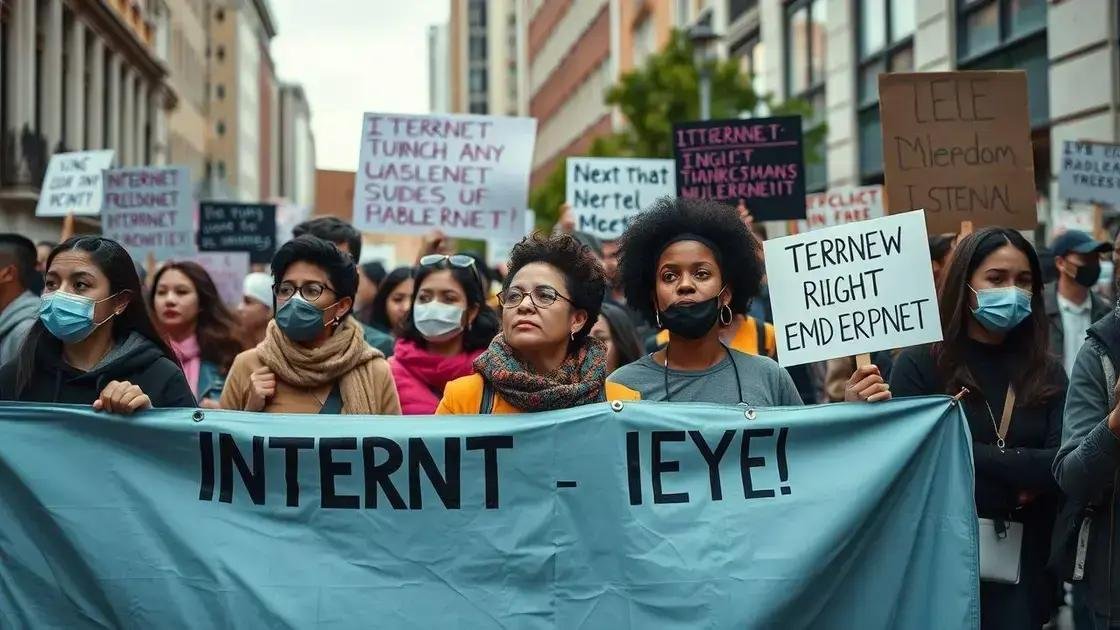Digital rights activism focuses on protecting individual freedoms, privacy, and equality in the digital domain, addressing challenges posed by emerging technologies and outdated legislation.
Digital rights activism protests play a significant role in shaping today’s digital landscape. Have you ever wondered how these movements can influence policies and promote freedoms in our increasingly online lives? Let’s explore their importance.
Understanding digital rights activism
Understanding digital rights activism is essential in today’s online world. This movement aims to protect individual freedoms and ensure privacy in the digital age. As technology evolves, so do the challenges faced by activists advocating for digital rights.
The importance of digital rights
Digital rights encompass various freedoms that people should have online, such as free speech, privacy, and access to information. These rights are vital as they allow individuals to express themselves without fear of censorship. Moreover, understanding these rights can empower users to take action when their freedoms are threatened.
- Access to the internet should be a basic right.
- Privacy is essential for personal security.
- Freedom of expression must be upheld online.
Activists work tirelessly to highlight issues like government surveillance and data privacy breaches. Education plays a critical role in this movement. By informing individuals about their digital rights, activists encourage them to stand up against injustices. Community efforts can lead to significant changes, driving public policy forward.
Major themes in digital rights activism
Some key themes include net neutrality, which ensures equal access to the internet without discrimination. Additionally, the fight against digital surveillance is crucial for maintaining personal privacy. Many organizations work globally towards securing these rights for all.
- Net neutrality promotes equal internet access.
- Fighting against surveillance protects privacy.
- Data protection laws are essential for safety.
By advocating for these themes, digital rights activists can influence legislation and create a safer online environment. Engagement in this space is essential for building a future where digital rights are recognized and respected.
The rise of protests for digital freedom
The rise of protests for digital freedom has transformed the way we view our rights online. Many people have taken to the streets to demand greater protections for their digital rights. These movements are fueled by increasing concerns over surveillance, data privacy, and internet access.
Key drivers of activism
Several factors have contributed to the surge in protests advocating for digital freedom. One major influence is the widespread reporting on government surveillance programs. This has raised awareness among citizens about how their personal data is collected and used without their consent. Additionally, the emergence of social media platforms has provided a new space for activists to organize and mobilize.
- The increasing visibility of surveillance issues.
- Social media’s role in organizing protests.
- Public frustration with data privacy breaches.
As individuals become more aware of these issues, the demand for digital rights has grown. Protesters are often motivated by a desire for transparency in government actions and accountability from tech companies. As more people join the conversation, the movement for digital freedom continues to gain momentum.
Examples of significant protests
In recent years, several high-profile protests have highlighted the fight for digital rights. For instance, the protests following the revelations of widespread government surveillance sparked discussions worldwide. Activists have gathered in various cities to demand changes in laws governing data protection and privacy.
- Protests against the USA PATRIOT Act.
- Marches for privacy rights in different countries.
- Global movements like the hacktivist group Anonymous.
These events showcase the collective power of individuals standing up for their rights online. The growth of these movements emphasizes the public’s demand for stronger protections in an increasingly digital world.
Key movements and their goals

Key movements in digital rights activism focus on various goals that promote freedom, privacy, and equality in the digital realm. These movements are diverse and have emerged in response to growing concerns about how technology affects individual rights.
Notable movements
One significant movement is the Electronic Frontier Foundation (EFF), which advocates for civil liberties in the digital world. They work on issues like free speech, privacy rights, and government surveillance. Another influential group is Access Now, dedicated to defending and extending the digital rights of users worldwide.
- The EFF focuses on protecting digital privacy.
- Access Now campaigns for internet access for everyone.
- Privacy International highlights the need for data protection.
Each movement aims to raise awareness about the importance of digital rights and encourage people to take action. For instance, Privacy International exposes unjust practices by governments and corporations that threaten individual privacy.
Goals of digital rights movements
The primary goals of these movements often include ensuring net neutrality, advocating against government surveillance, and protecting personal data. They strive to create a digital landscape where everyone has equal access to the internet, free from oppressive restrictions. Activists organize campaigns and protests to push for legislation that supports these objectives.
- Ensuring net neutrality for equal access.
- Fighting against invasive surveillance practices.
- Promoting data protection laws to safeguard personal information.
Through persistent efforts, these movements aim to create a future where digital freedoms are upheld, and users can navigate the internet without fearing for their rights.
The impact of social media on activism
The impact of social media on activism has been profound, especially in the realm of digital rights activism. Social media platforms act as powerful tools that connect individuals and spread awareness quickly. These platforms provide an avenue for voices that might otherwise go unheard.
Connecting activists globally
One of the key ways social media influences activism is by connecting activists across the globe. Movements that start in one country can gain international support within hours. Hashtags like #FreeTheInternet have brought together supporters fighting for digital freedom in various regions.
- Activists share information and strategies.
- Global support can amplify local movements.
- Real-time updates engage followers and boost participation.
This global connection also leads to the sharing of resources and tactics, helping smaller movements learn from those with more experience. As more people join the conversation, they create a larger, unified front.
Raising awareness and driving engagement
Social media platforms are excellent for raising awareness about pressing issues. By sharing stories and engaging content, activists can draw attention to causes such as data privacy and government surveillance. This engagement can turn casual observers into passionate advocates.
- Eye-catching images and videos can convey powerful messages.
- Online petitions can garner thousands of signatures quickly.
- Live streams of events can draw virtual audiences.
The ability to create viral content means that a single post can reach thousands or even millions of people. This exposure can lead to increased support and pressure on policymakers to act. Activism born on social media can translate into real-world change, influencing public opinion and driving political response.
Future challenges for digital rights
Future challenges for digital rights are becoming increasingly complex as technology evolves. New technologies bring fresh opportunities but also unique issues that activists must address. As we advance into an even more digital world, understanding these challenges will be essential for protecting our rights.
Emerging technologies
The rise of technologies like artificial intelligence and deep learning poses significant risks to digital rights. These tools can analyze vast amounts of data, which may lead to intrusive surveillance or biased decision-making. Without proper regulations, the misuse of such technologies could infringe on privacy rights and personal freedom.
- AI algorithms may perpetuate biases.
- Automation can lead to job displacement.
- Deep learning can improve surveillance capabilities.
As these technologies advance, it will be vital for advocates to push for guidelines that ensure ethical use and protect individual rights. This can help prevent technology from being used against the very people it is meant to serve.
Legislative hurdles
Legislation is often slow to catch up with the rapid pace of technological change. This delay creates gaps in legal protections for digital rights. Activists face the challenge of working within outdated frameworks while trying to propose new laws that address modern issues such as data privacy and consent.
- Policies need to adapt to new digital realities.
- Global cooperation is necessary for effective laws.
- Public awareness is crucial for initiating change.
By fostering a strong understanding of current challenges, activists can advocate for legislation that safeguards rights in the digital age. Building strong coalitions with international partners can further enhance these efforts.
Public perception and awareness
Another challenge is the general public’s understanding of digital rights. Many individuals may not realize the extent of their rights online, making it harder to mobilize support for causes. Activists must find ways to educate the public about the importance of these rights and how they can get involved.
- Use social media campaigns for awareness.
- Create informative content that is easily shared.
- Host community events to engage citizens.
By increasing awareness and fostering dialogue, the movement can grow stronger and more effective in addressing future challenges.
FAQ – Frequently Asked Questions about Digital Rights Activism
What is digital rights activism?
Digital rights activism focuses on protecting individual freedoms, privacy, and equality in the digital space, often through protests and advocacy.
How does social media impact digital rights activism?
Social media allows activists to connect globally, raise awareness quickly, and mobilize support for digital freedom initiatives.
What are some major challenges for digital rights in the future?
Emerging technologies, outdated legislation, and public awareness pose significant challenges to safeguarding digital rights.
How can individuals get involved in protecting digital rights?
Individuals can get involved by educating themselves, participating in campaigns, and advocating for policy changes that protect digital freedoms.

